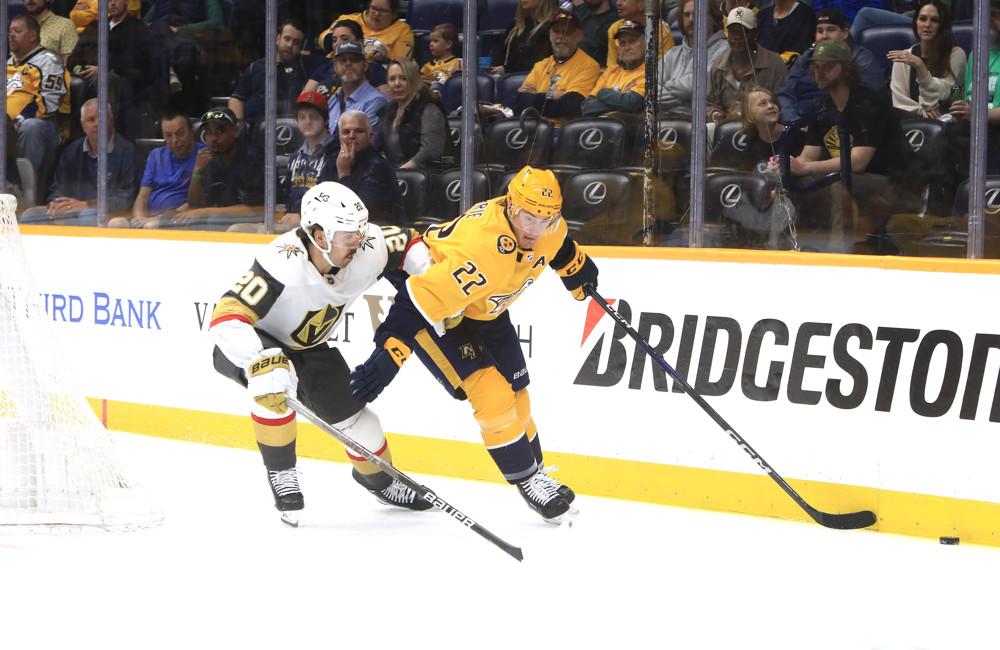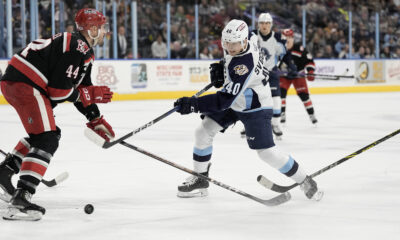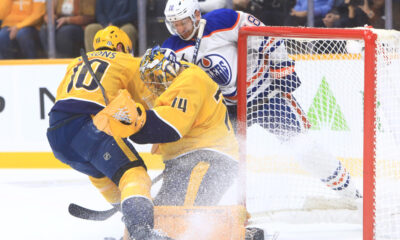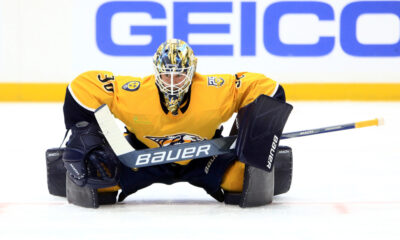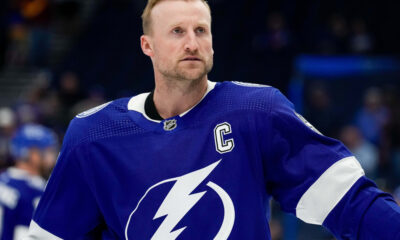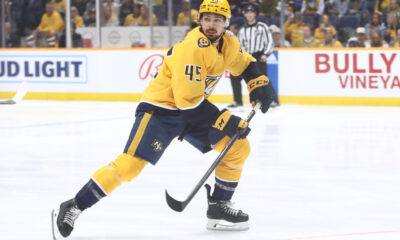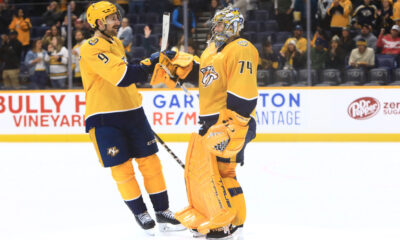The Nashville Predators were one of the worst defensive teams in the NHL this past season.
That statement just feels blasphemous, doesn’t it? After all, these are the Nashville Predators we’re talking about; being good in the defensive end of the ice is their whole thing. Kimmo Timonen, Marek Zidlicky, Shea Weber, Ryan Suter, Roman Josi, Ryan Ellis, and Mattias Ekholm were guaranteed to make life hell for opposing offenses, and whenever a team DID manage to get past that wall, Tomas Vokoun, Pekka Rinne, and Juuse Saros were there to close the door.
And yet statistically, the Predators were right at the bottom of the league in a number of key defensive metrics. According to Natural Stat Trick, they were 30th in Corsi Against (shot attempts against, essentially) per 60 minutes. Only the Anaheim Ducks and the Columbus Blue Jackets, the two worst teams in NHL points-wise, were worse; even the Chicago Blackhawks, authors of the most transparent tank job in years, did better at shot suppression than the Preds.
The Predators were also towards the bottom in Corsi For Percentage (24th overall), expected goals against per 60 minutes (28th), and high-danger chances against per 60 minutes (24th.) In fact, the only defensive categories the Predators did relatively well in were blocked shots (8th) and goals against per 60 minutes (12th), the latter of which truly highlights just how much of a disaster this season could have been if not for Saros’s unbelievable season.
| Season | Corsi Against/60 (NHL Rank) | Corsi For % (NHL Rank) | Goals Against/60 (NHL Rank) | Expected Goals Against/60 (NHL Rank) | High-Danger Chances Against/60 (NHL Rank) |
|---|---|---|---|---|---|
| 2017-18 | 56.61 (15th) | 51.48% (10th) | 2.0 (1st) | 2.34 (10th) | 10.51 (16th) |
| 2018-19 | 54.73 (8th) | 52.24 (7th) | 2.16 (4th) | 2.35 (11th) | 10.81 (17th) |
| 2019-20 | 57.38 (22nd) | 50.94 (10th) | 2.46 (14th) | 2.35 (13th) | 10.87 (17th) |
| 2021 | 54.18 (18th) | 49.86 (15th) | 2.0 (4th) | 2.27 (15th) | 9.82 (13th) |
| 2021-22 | 54.92 (15th) | 49.72 (17th) | 2.56 (14th) | 2.33 (7th) | 9.62 (4th) |
| 2022-23 | 61.36 (30th) | 47.41 (24th) | 2.36 (12th) | 2.88 (28th) | 12.73 (24th) |
With new head coach Andrew Brunette coming into the fold, a lot of the conversation has revolved around the offense, given Brunette’s reputation as a “run and gun” all-out defensive coach. But if he wants to have a successful debut season with the Predators, Brunette will need to figure out a way to restore the Preds’ blueline to their former glory.
Projected Lineup
That task will need to start with Roman Josi. The Predators’ captain led the Preds in scoring for the fourth consecutive season, becoming just the third defender to accomplish that feat in the past 50 years (Bobby Orr and Erik Karlsson are the others.) His 253 points over the past four seasons lead all NHL defensemen in that category.
With the offseason overhaul amongst the forward corps, the Preds will likely rely on Josi’s scoring prowess this season. The more interesting question, however, is how Brunette chooses to deploy him in key defensive situations. Under John Hynes, Josi’s ice time was mostly reserved for key offensive opportunities or late in the game when the Preds were trailing. Over the past two year, nearly 67% of Josi’s zone starts came in the offensive zone. Compare that to his Norris Trophy-winning 2020 season, where his zone starts were split closer to 50-50 between the offensive and defensive zones.
| Season | Offensive Zone Start % | Defensive Zone Start % |
|---|---|---|
| 2015-16 | 50.2 | 49.8 |
| 2016-17 | 51.6 | 48.4 |
| 2017-18 | 49.1 | 50.9 |
| 2018-19 | 50.6 | 49.4 |
| 2019-20 | 52.9 | 47.1 |
| 2021 | 64.3 | 35.7 |
| 2021-22 | 67.2 | 32.8 |
| 2022-23 | 66.2 | 33.8 |
A big part of that equation could be who Josi’s regular defensive partner is. All signs point that being — at least part of the time — new addition Luke Schenn. Just a few seasons removed from being buried in the AHL, the 33-year-old has gained new life in the league thanks to playing in role in Tampa Bay’s two Stanley Cup runs and his chemistry with top defenders Quinn Hughes and Morgan Rielly. However, being Josi’s regular partner will likely require a lot of minutes, and given Schenn hasn’t averaged more than 17:13 per game in a season since 2016, that may be a big ask of the journeyman d-man.
The Predators should find more consistency on their second pair this season with veterans Ryan McDonagh and Tyson Barrie holding the fort. Both players stepped up in a big way after the Preds traded Mattias Ekholm and lost Josi and Alexandre Carrier at the deadline, and many of the younger call-ups lauded both players for their ability to keep the locker room focused amidst the roster turnover.
Barrie, 32, is a solid puck-mover who quietly put up 55 points last season. He’s in the final year of his contract and will likely attract some trade interest from contenders should the Preds struggle this season. But while he’s here, he should provide with a strong secondary scoring threat from the blueline when Josi’s off the ice.
McDonagh, 34, isn’t quite the two-way threat he was during the 2010s, but he’s proven to be reliable in his own end, an effective penalty killer, and a player the Preds can count on to make smart plays under pressure in key moments. As long as Barrie is there to handle the transitional game for that pair, McDonagh should counted on as another key player capable of eating up big moments.
What the Predators decide to do with the bottom pair will be the big question mark heading into the season. That pair will consist of a combination of Alexandre Carrier, Dante Fabbro, and Jeremy Lauzon. Three players who appeared to be central pieces of the Predators’ future just a year ago now seem to be fighting for consistent playing time.
With Lauzon the only left-handed shot amongst the three, and with three years left on his contract, it’s a safe bet he’ll be penciled in to start on the left side of the bottom pair. That could leave Carrier and Fabbro in a battle for the final regular spot. Both players signed near-identical one-year extensions earlier this year, and it’s not unfair to question whether this year is their last chance to impress the Preds’ new braintrust. Carrier will be trying to move past his injury-riddled 2023 season and return to the form from a season prior that earned him a spot on the NHL’s All-Rookie Team. Fabbro, at one point the Predators’ highest-rated prospect, may not ever become the two-way threat Preds fans hoped he would be, but if he can battle through some of his inconsistencies, there’s still hope for him to be a reliable bottom-four defenseman in the right situation.
2023-24 Outlook
A big part of the defensive workload will come down to puck possession. Brunette’s system emphasizes securing possession and aggressively chasing the puck, and if the Preds are successful in doing that, we could see fewer games with 35-40 shots allowed, something that became routine for the Preds last year. Even a small improvement can do wonders for the Preds and lessen the burden on Juuse Saros.
There are naturally a lot of unknowns that’ll dictate that success. Can Schenn play consistent top-pair minutes? Will McDonagh and Barrie fight off regression? Will Carrier return to form? And will the forwards gel well enough to be able to maintain possession?
If all goes well, the Preds’ defense could pace the team to a surprising finish. If it doesn’t, brace yourself for a season just as bad — if not worse — than last year’s.

